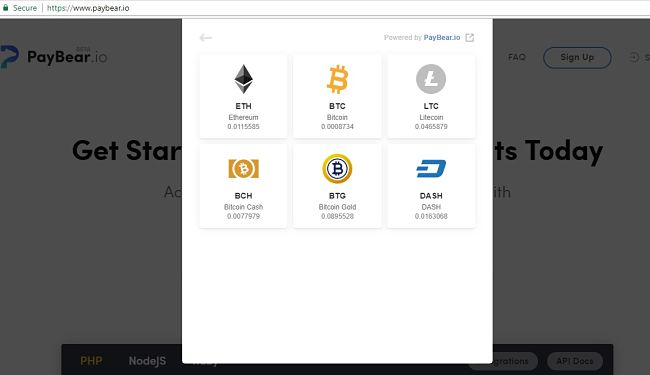When Bitcoin was first introduced in 2009, Satoshi Nakamoto, its creator, heralded the cryptocurrency as ‘peer-to-peer electronic cash’. Nearly an entire decade later in 2018, Bitcoin and every other digital currency out there is still struggling to make mass adoption a reality.
In this article, we are delving into the PayBear review, detailing on the cryptocurrency payment gateway.
Simply put, while the common folk may want to jump on the concept of decentralization and cross-border low fee transactions until they can easily purchase goods and services with it, digital currencies are not even regarded as possible alternatives to fiat currencies by them.
Furthermore, in its current state, for a merchant to begin accepting Bitcoin or any other digital currency, they need to embrace the caveat of building their own infrastructure to do so.
Just like with credit cards, while some companies have the raw manpower and knowledge to do so, most smaller businesses will opt to use a pre-designed solution instead. In the non-crypto world, that space has been largely dominated by PayPal and Stripe, two payment gateways that have become the de facto choice for several years now.
Considering that, the crypto industry has probably finally realized it is in need of a solution.
Similar to how PayPal provides a layer of abstraction wherein you can digitally send your money to anyone else using only their email address, startups such as PayBear are attempting to simplify cryptocurrency payments for merchants as well as end users.
It is, however, important to note that PayBear’s cryptocurrency-oriented payment gateway is not the first of its kind. Similar attempts to reconcile Bitcoin payments with ordinary merchants have been made in the past, with BitPay being the most successful one.
In 2013, Steam and Microsoft were two major companies that accepted Bitcoin using the BitPay payment platform.
PayBear, a new entry into the crypto payments market, also boasts more than seven support cryptocurrencies. BitPay, on the other hand, has expressed no interest in adding payments in digital currencies other than Bitcoin and one of its forks, Bitcoin Cash.
Given that Bitcoin can sometimes be infeasible for small transactions and that some individuals prefer using other currencies, support for alternatives such as Litecoin, Ethereum and Dash are imperative today.
PayBear has announced that they will not only support 7 major cryptocurrencies at launch but will also be adding 11 others sometime in the second quarter of 2018.
 Supported cryptocurrencies
Supported cryptocurrencies
With some new cryptocurrencies promising feeless and instantaneous transfers, it is likely that PayBear will adopt them in the future. Nano is one such cryptocurrency and has been making waves in the digital currency community for that exact reason.
Considering that most of the transfer fee charged by payment gateways such as BitPay and PayBear is due to the specific cryptocurrency’s network fees, using proof of stake currencies will reduce.
PayBear has stated that it will not be charging any fee for merchants using its service as an introductory offer. The only amount charged will be the 2 cent Ethereum network fee, which is unavoidable, at least until Ethereum’s Casper undertaking is fully deployed on the main net.
In comparison to fiat payment gateways such as PayPal and Stripe, it is quite obvious that PayBear has almost negligible fees. According to a comparison slider on PayBear’s website, merchants can enjoy anywhere from 20 to 1000 times lesser fees by choosing the cryptocurrency gateway.
The elephant in the room, however, is that the company has not publicly announced how long the introductory fee period will last or what percentage they will be charging per transaction post that.
It is likely that the company will match BitPay’s 1 percent fee model but given that it is the only gateway offering altcoin payments, it is also possible that they will try to cash in on the exclusivity. Nevertheless, some clarity on the proposed fee structure from PayBear would go a great way to boost merchant confidence in the platform.
An important feature missing from the platform appears to be automatic crypto to fiat conversion and the direct bank payout feature.
For businesses that do not wish to deal with the volatility of the cryptocurrency market first hand, but still offer it as a payment method, these features are somewhat vital as they provide the necessary abstraction layer to eliminate price fluctuations.
It is quite apparent that the company has made availability on popular e-commerce platforms a top priority. At the time of writing this article, integrations for WooCommerce, PrestaShop, and OpenCart are already live, with Magneto support reportedly coming soon.
For custom websites, PayBear is also offering their API to merchants as is standard for any modern payment gateway.
According to the roadmap published on PayBear’s website, the company has several new features in the pipeline. Multi-currency wallets are expected to go live in the second quarter of 2018, with crypto to crypto conversions shortly after that.
From the company’s explainer video and roadmap, it looks like most of the planned features mirrors the ones offered by PayBear’s competitors. A prepaid debit card, for instance, is one of the most popular fiat related feature offered by cryptocurrency payment gateways.
As of now, PayBear has stated that the payment gateway, while completely “production ready”, is still in beta. It is likely that the free introductory pricing is because the platform is still under active development.
The appeal of PayBear is easy to understand, as it promises lightning-quick cryptocurrency payments with very little to no effort on the merchant’s end. What remains to be seen, however, is whether any major company will bet on the infrastructure a la Steam and Microsoft and what the monetization strategy will be for the company.
Hope this PayBear review gave you a clear idea about the cryptocurrency payment gateway.
Let me know what you think in the comments below!
Feature image by Mustafa Kural
 Supported cryptocurrencies
Supported cryptocurrencies